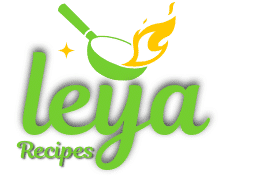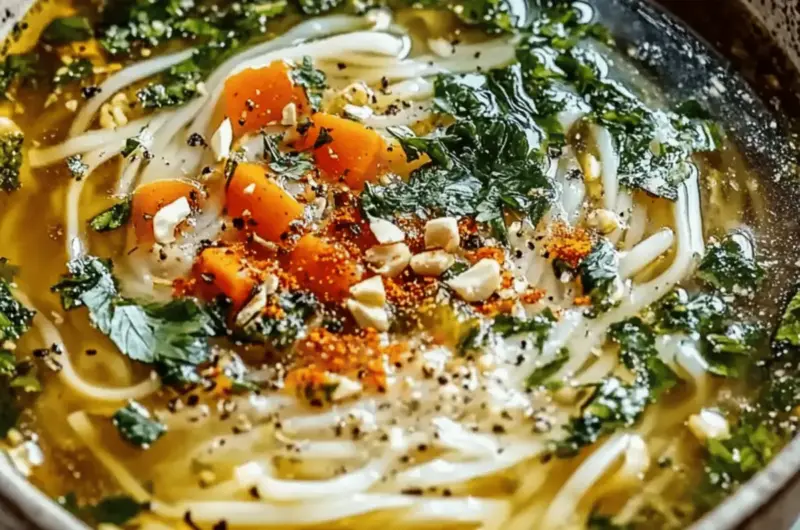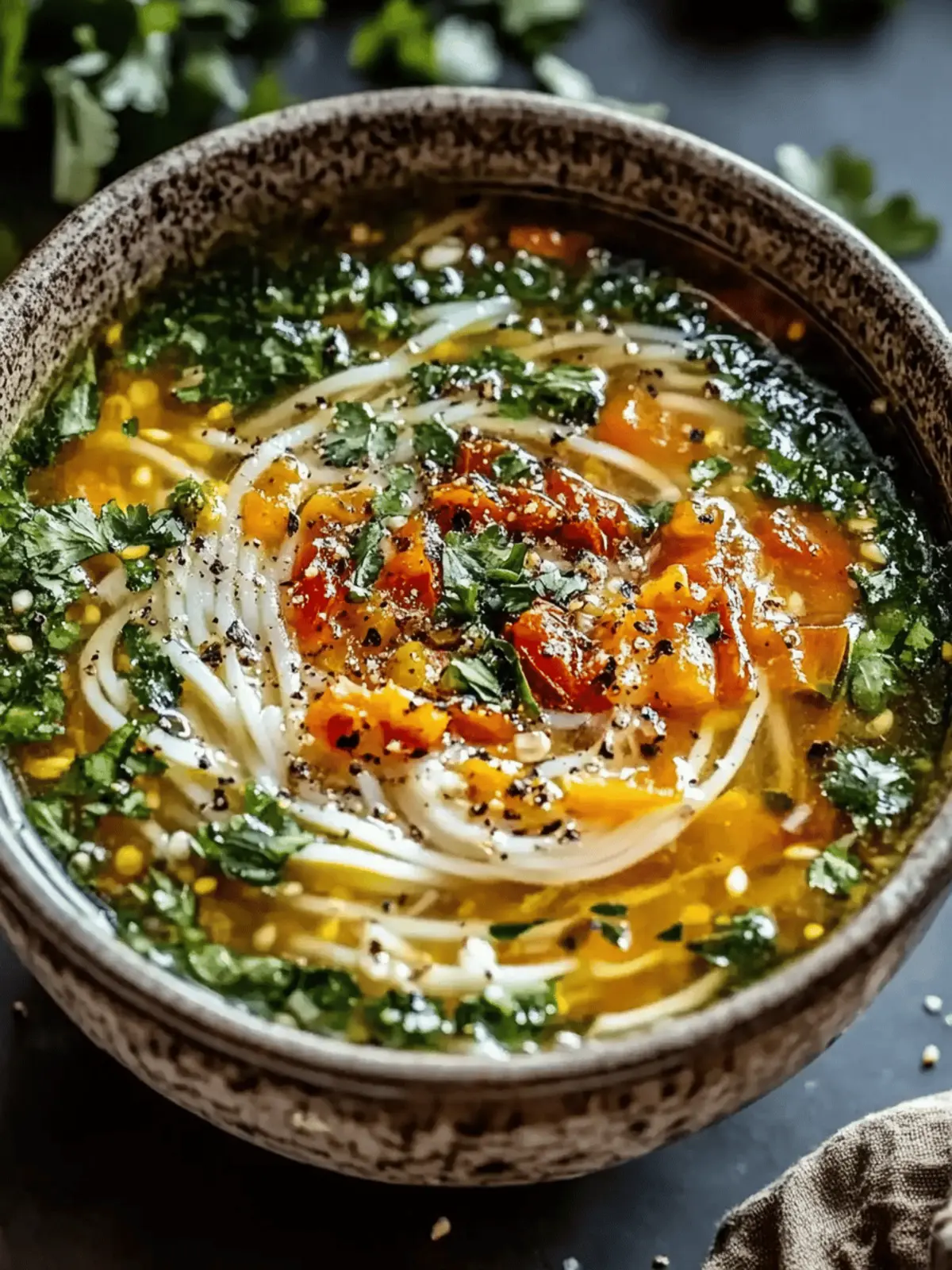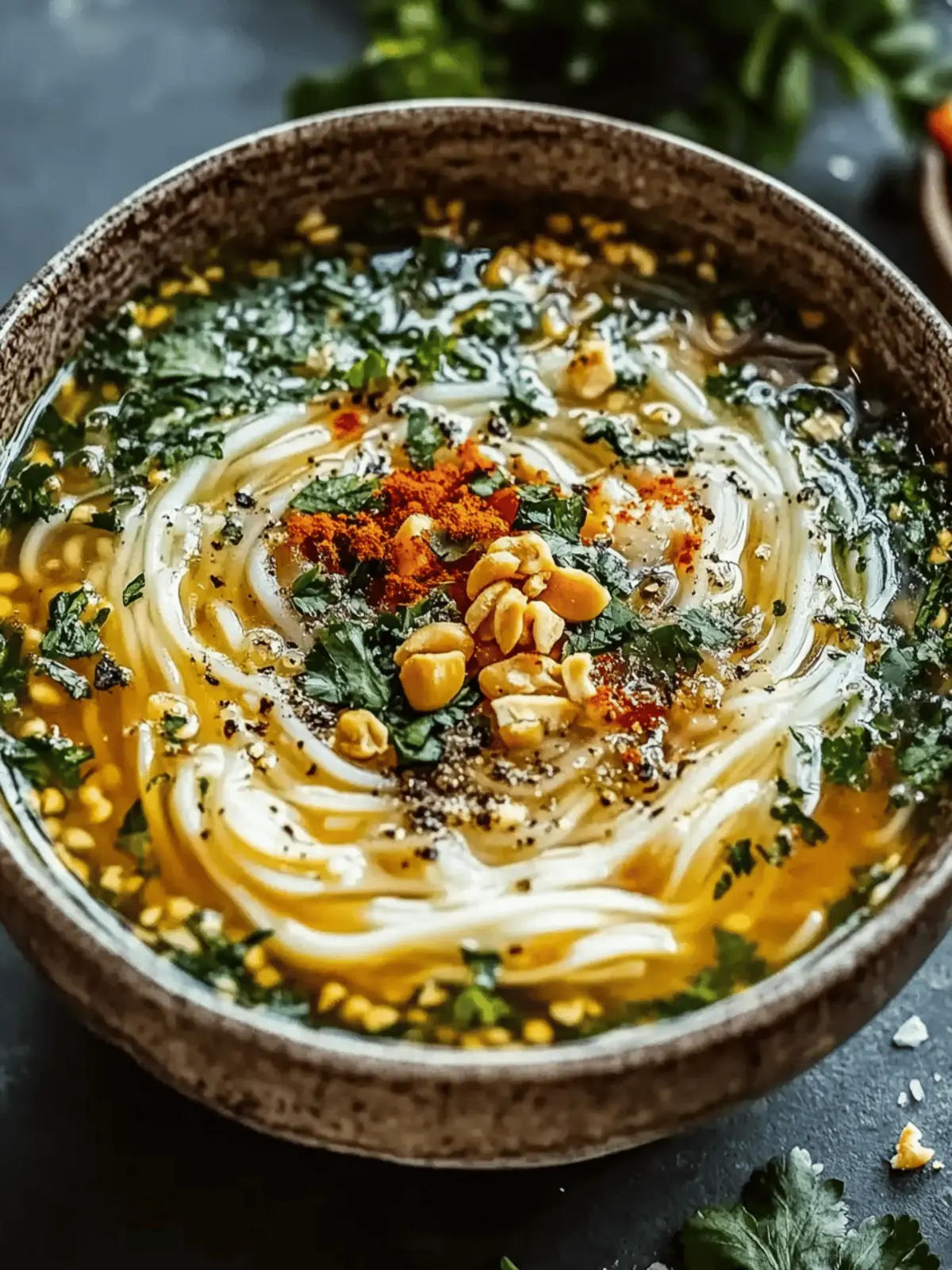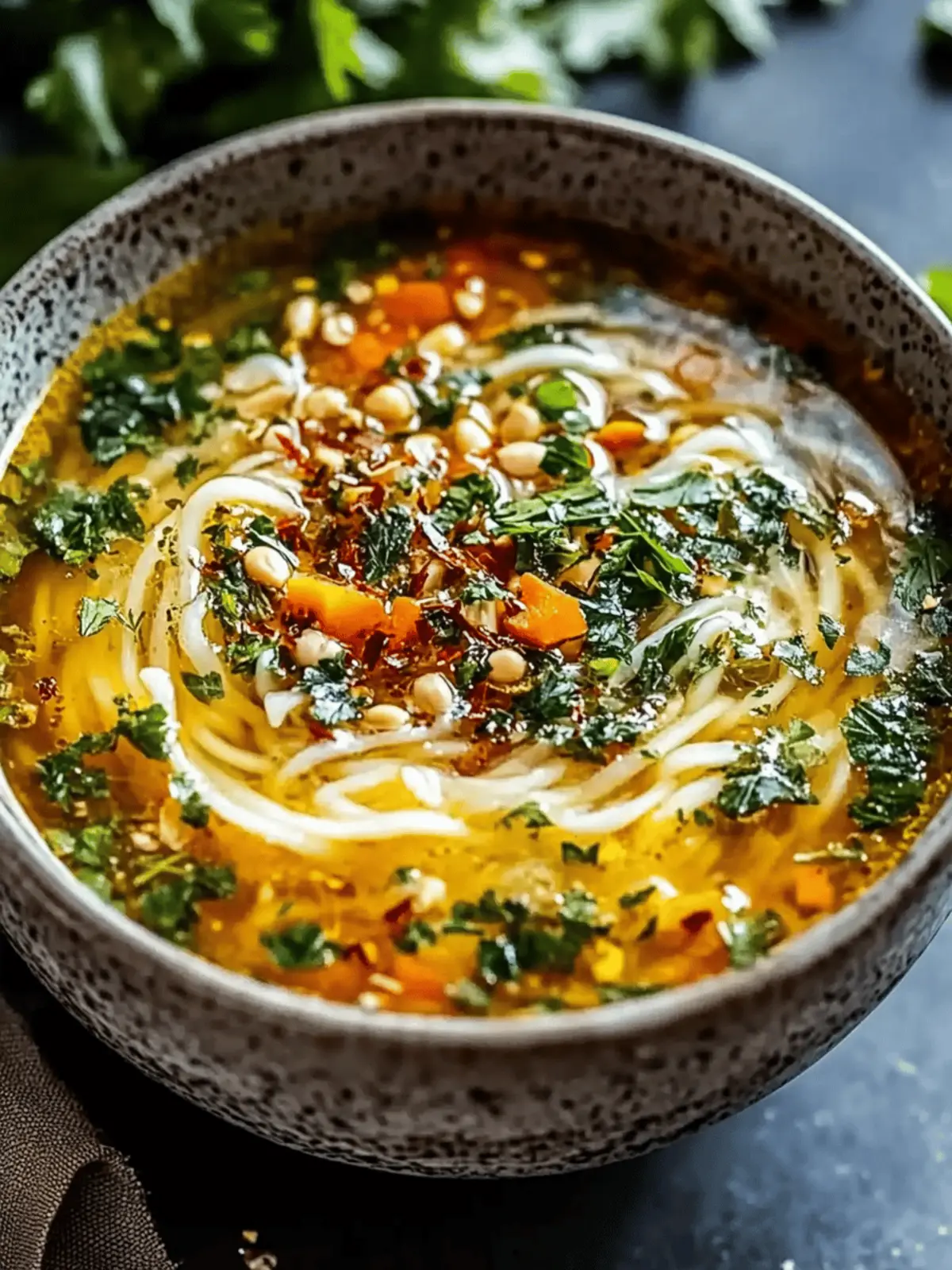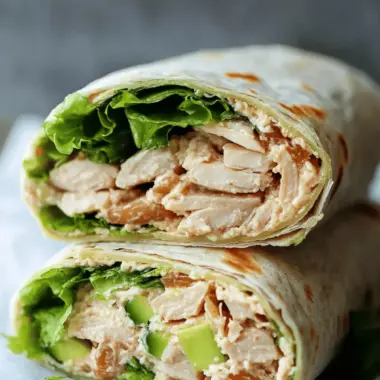There’s something wonderfully heartwarming about a big pot of Persian Noodle Soup, or Ash Reshteh, bubbling away on the stove. The comforting aroma of sautéed onions mingling with garlic and turmeric instantly transports me to my favorite cozy kitchen moments. This dish is more than just a meal; it’s a celebration of nourishing ingredients, vibrant flavors, and rich cultural tradition. Each bowl is packed with hearty legumes, fresh herbs, and thick noodles, creating a medley that warms both the body and soul.
Whether it’s a chilly day or you’re simply craving something wholesome, this vegan delight checks all the boxes—it’s nutritious, easy to prepare, and unbelievably satisfying. Imagine gathering around the table with loved ones, sharing stories and laughter, as you all dig into a comforting bowl of this ancient Persian recipe. Trust me, this soup is bound to disappear faster than you can say “Ash Reshteh.” Are you ready to dive into this flavorful journey? Let’s get cooking!
Why is Persian Noodle Soup a must-try?
Hearty, nourishing flavors: This Persian Noodle Soup (Ash Reshteh) is a delicious way to indulge in a healthful meal that satisfies the whole family.
Simple preparation: With just one pot needed, this recipe allows you to enjoy a comforting dish without extensive cleanup.
Versatile ingredients: Customize the soup to your taste by adding extra greens or spice for a personal touch!
Cultural connection: Enjoying this soup means embracing rich Persian traditions, making every bowl a lovely experience.
Perfect for sharing: Gather around the table with loved ones for a warm and hearty meal that sparks joy and conversation.
Meal prep friendly: Make a big batch for easy storage; it keeps well for days, ensuring you have comfort food whenever you need it!
Persian Noodle Soup Ingredients
For the Soup
• Legumes (lentils, beans) – Provide protein and hearty texture; consider chickpeas or black beans as alternative options.
• Noodles (reshteh or flat noodles) – Add substance and heartiness to the soup; substitute with rice or gluten-free noodles if needed.
• Fresh herbs (parsley, cilantro, green onions) – Infuse the soup with aromatic flavors; fresh dill or mint can be delightful alternatives.
• Onion – Creates the soup’s base flavor and adds sweetness when sautéed; shallots can provide a milder taste.
• Garlic – Delivers depth of flavor; feel free to adjust the amount based on your preference.
• Turmeric – Adds earthy flavor and vibrant color; replace with saffron for a more luxurious touch.
• Vegetable broth – Forms the soup’s foundation and contributes umami flavors; use homemade broth for richer taste or water in a pinch.
• Yogurt or sour cream (for garnish) – Offers a tangy finish; substitute with vegan yogurt or omit for a dairy-free option.
How to Make Persian Noodle Soup
-
Sauté onions: Begin by heating a large pot over medium heat. Add chopped onions and sauté until they are translucent, creating a gentle sweetness that forms the soup’s base.
-
Add garlic and turmeric: Next, stir in minced garlic and turmeric, cooking this fragrant mixture for about a minute. This step is crucial for layering those warm, earthy flavors.
-
Incorporate legumes and noodles: Add your choice of legumes and noodles to the pot, followed by the vegetable broth. Bring everything to a rolling boil, allowing those ingredients to mingle.
-
Simmer the soup: Once boiling, reduce the heat and let the soup gently simmer for approximately 30 minutes, or until the legumes are tender and the noodles have cooked through.
-
Stir in fresh herbs: Finally, fold in a generous amount of fresh herbs, adjusting seasoning to your taste. This adds a burst of aromatic freshness to the hearty mixture.
-
Serve and garnish: Ladle the soup into bowls while it’s still steaming hot. Garnish each serving with a dollop of yogurt or sour cream if desired, adding a delightful tang.
Optional: Add a sprinkle of crushed red pepper for a touch of heat.
Exact quantities are listed in the recipe card below.
Expert Tips for Perfect Persian Noodle Soup
- Pre-soak Legumes: Soaking your dried legumes ahead of time not only reduces cooking time but also helps achieve a creamier texture in your Persian Noodle Soup.
- Stir Occasionally: To avoid sticking, make sure to stir the soup every so often while it simmers. This keeps the ingredients evenly mixed and flavorful.
- Layer Flavors: For an even richer taste, try sautéing the fresh herbs along with the onions and garlic for a minute before adding the liquids.
- Check Noodle Texture: Be mindful of the noodle cooking time; you want them to be tender but not overly mushy, adding to the soup’s comforting texture.
- Adjust Seasoning: Taste your soup before serving. If it needs a bit more depth, a pinch of salt or squeeze of lemon juice can brighten all the flavors!
Make Ahead Options
Persian Noodle Soup is an excellent choice for meal prep aficionados looking to save time during busy weeks! You can prepare the soup up to 24 hours in advance by cooking the entire dish and refrigerating it in an airtight container to preserve flavors. For added convenience, chop the onions, garlic, and herbs a day before, placing them in separate containers, so they are ready to sauté when you decide to cook. When you’re ready to serve, reheat the soup on the stove over medium heat, adding a splash of broth or water to maintain the desired consistency. This advance preparation ensures that your Persian Noodle Soup remains just as delicious and comforting, ready for you to enjoy with minimal effort!
Storage Tips for Persian Noodle Soup
Room Temperature: Serve the soup immediately after cooking for the best taste; avoid leaving it out for more than 2 hours to ensure safety.
Fridge: Cool completely before storing in an airtight container; this Persian Noodle Soup can be refrigerated for up to 3 days for optimal freshness.
Freezer: For longer storage, freeze in portions using freezer-safe containers; it can be kept for up to a month. Thaw overnight in the fridge before reheating.
Reheating: Gently heat on the stove over low-medium heat, stirring occasionally, until warmed through. You may want to add a splash of broth or water to revive the soup’s texture.
What to Serve with Persian Noodle Soup?
Cozy up with the delightful aroma of this nourishing soup, and let’s explore perfect pairings that elevate your meal experience.
- Crusty Bread: Perfect for dunking, warm, crusty bread adds texture and soaks up the rich flavors of the soup beautifully.
- Fresh Salad: A light, herby salad with citrus dressing complements the hearty soup, balancing it with brightness and crunch.
- Roasted Vegetables: The caramelized sweetness of roasted veggies contrasts wonderfully with the savory depth of the Persian Noodle Soup, making every bite dynamic.
- Warm Pita Bread: Soft and fluffy, warm pita is fantastic for wrapping around spoonfuls of soup, enhancing the experience with its comforting nature.
- Spiced Rice: Fragrant, seasoned rice can provide additional heartiness, making your meal even more fulfilling and delightful.
- Mint Yogurt Dip: A refreshing, tangy yogurt dip with mint offers a cool contrast to the warm soup while enhancing its flavors delightfully.
- Herbed Quinoa: Nutty and fluffy, herbed quinoa adds a twist to the meal while keeping everything vegan and nutritious.
- Citrusy Lassi: A cool, creamy lassi with a hint of citrus can be a delightful drink choice, complementing and refreshing your palate as you enjoy the soup.
Persian Noodle Soup Variations
Get creative and make this beloved soup your own with a few simple tweaks!
- Leafy Greens: Add in chopped spinach or kale for extra nutrition and a pop of color. Both options will enhance the bowl’s heartiness without overpowering the flavors.
- Spicy Twist: For those who love a little heat, sprinkle in crushed red pepper flakes or diced jalapeños. Just remember to adjust the quantity based on your spice tolerance!
- Creamy Alternative: Swap the yogurt garnish for a drizzle of tahini or nut-based cream for a different creamy finish that balances beautifully with the soup’s flavors.
- Nutty Flavor: Toasted pine nuts or slivered almonds can be sprinkled on top for added crunch and a delightful nutty flavor. They’ll bring an excellent texture contrast to the soup.
- Herb Medley: Try using fresh dill or mint instead of traditional herbs for a refreshing twist. Each herb brings its unique flair, transforming your soup in delightful ways.
- Saffron Infusion: For a luxurious flavor upgrade, replace the turmeric with saffron. This elevates the dish’s essence while imparting a golden hue that delights the eyes as well as the palate.
- Legume Variety: Experiment with different legumes like kidney beans or black-eyed peas for a new taste and texture. Each bean type adds its unique charm to the dish.
- Citrus Zing: A squeeze of fresh lemon or lime juice just before serving can brighten the overall flavor, adding a refreshing finish that cuts through the heartiness of the soup.
With these variations, your Persian Noodle Soup will never get boring! Enjoy customizing and sharing the love with family and friends.
Persian Noodle Soup Recipe FAQs
How do I select the right legumes for my Persian Noodle Soup?
Absolutely! When choosing legumes, opt for those that are fresh and vibrant. If you’re using dried lentils or beans, check for any dark spots or noxious odors, which may indicate spoilage. I often prefer a mix of lentils and chickpeas, as they provide a nice variation in texture!
What’s the best way to store leftover Persian Noodle Soup?
Very! To keep your soup fresh, allow it to cool completely before transferring it to an airtight container. It can be safely refrigerated for up to 3 days. I always recommend labeling the container with the date to keep track!
Can I freeze Persian Noodle Soup for later use?
Yes, indeed! To freeze, portion the cooled soup into freezer-safe containers, allowing some space at the top for expansion. It can be frozen for up to 3 months. When you’re ready to enjoy it, simply thaw overnight in the fridge and reheat gently on the stove, adding a little broth if needed.
What if my noodles turn mushy while cooking?
Ah, yes! If your noodles are mushy, it may be due to cooking them for too long. To avoid this, be sure to cook them al dente before adding them to the soup. If they’re already overcooked, don’t worry; you can still enjoy the delicious flavors—just serve immediately for the best texture!
Are there any dietary considerations I should keep in mind?
Certainly! This Persian Noodle Soup is naturally vegan, making it suitable for those avoiding animal products. However, if you plan to serve it to pets, be cautious; onion and garlic can be harmful to them. Always double-check for any allergies among your guests, especially when using legumes and herbs.
How can I enhance the flavor of my Persian Noodle Soup?
Great question! For an extra flavor boost, consider sautéing your herbs briefly with the onions and garlic before adding the broth. This process helps to release oils and deepen the overall taste. Additionally, a splash of lemon juice right before serving gives it a bright finish!
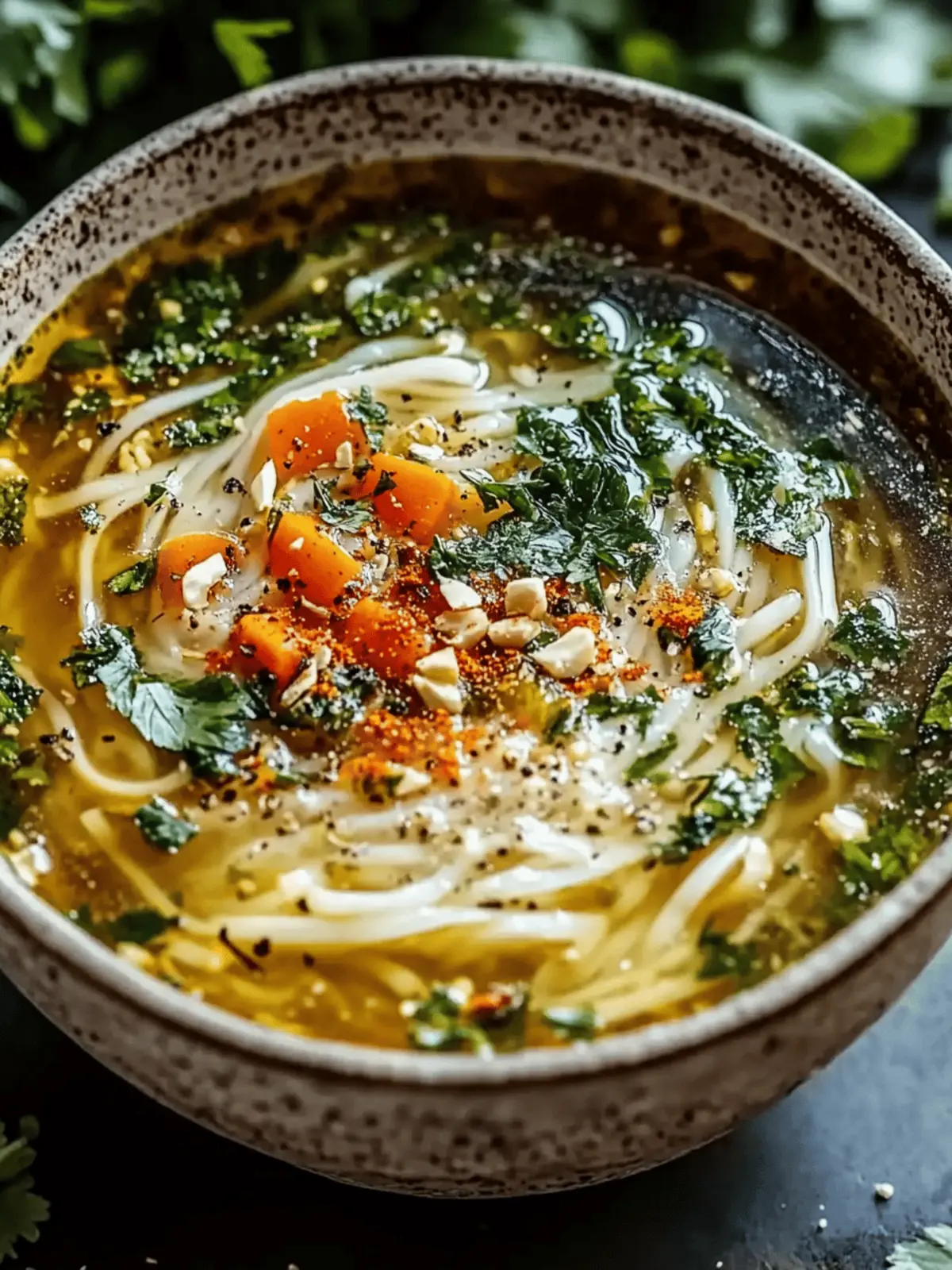
Nutritious Persian Noodle Soup for Cozy Comfort Anytime
Ingredients
Equipment
Method
- Sauté onions: Begin by heating a large pot over medium heat. Add chopped onions and sauté until they are translucent.
- Add garlic and turmeric: Stir in minced garlic and turmeric, cooking this fragrant mixture for about a minute.
- Incorporate legumes and noodles: Add your choice of legumes and noodles to the pot, followed by the vegetable broth. Bring to a rolling boil.
- Simmer the soup: Once boiling, reduce the heat and let the soup gently simmer for approximately 30 minutes.
- Stir in fresh herbs: Fold in a generous amount of fresh herbs, adjusting seasoning to your taste.
- Serve and garnish: Ladle the soup into bowls while it’s still steaming hot. Garnish with yogurt or sour cream if desired.
